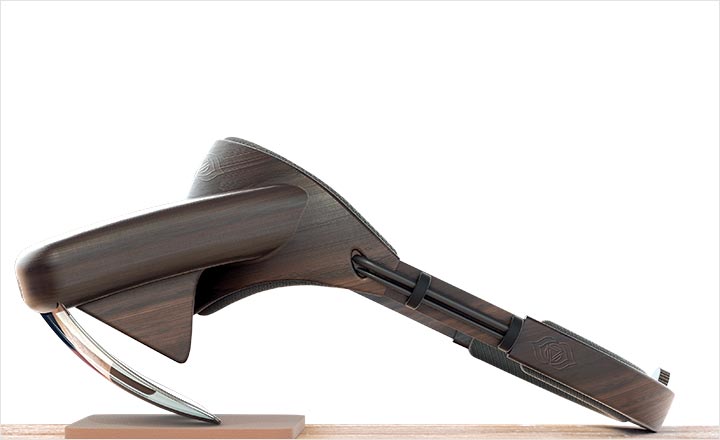As a student of mechanical engineering at IIT Bombay, Abhijit Patil was always interested in making machines. From a low-cost scanner and 3D printer to developing a technique to fast-track jaw surgery — by making a customised implant using 3D printing — Patil has several innovations to his credit. Thus, when a Google start-up event was held in the campus in 2014, it was the perfect opportunity for him to display his skills.
It was here that Patil met Abhishek Tomar and Pankaj Raut. Tomar was the technical director at Red Chillies Entertainment, specialising in VFX (visual effects). Raut, an electronics engineer from London’s Southbank University, worked with MIT Media Labs and iMakr on 3D printing technology. The trio formed a team, as their area of interest matched, and made a 3D fracture cast which won them the first prize. “That is when we saw we had a winning combination. I was interested in hardware, Pankaj in software and Abhishek in algorithms. Together, we wanted to create a tool that will change human life,” says Patil.
Cut to 2018, the trio is very close to achieving this dream. Their company, Dimension NXG, is the only Indian start-up to have created an augmented reality (AR) headset that is set to change the way humans see the world.
The AR headset, called AjnaLens, employs mixed reality to enable the physical and digital worlds to co-exist in real time. AjnaLens essentially creates virtual images that are displayed in the viewer’s real world, instead of displaying it on a screen.
This enables them to have a more immersive and interactive experience. In September this year, AjnaLens will be launched for enterprises, followed by a launch for consumers by 2020.

“During our brainstorming sessions, we realised that we want to take computers to the next level and develop tools to enable people to see the virtual objects in real life. Hence, the name Dimension NXG, which means dimension next generation,” says Patil, chief operating officer. Currently housed on the fourth floor of a commercial complex in Hiranandani Estate, Thane, Dimension NXG’s office is inconspicuous. However, their innovation is sure to put India on the world map, being the only Indian start-up to have designed an AR headset and only the fourth player globally.
Tomar, who is the chief technology officer, mentions that Ajna roughly translates to the power of sixth sense and is like the third eye. “We see AjnaLens making an impact in several industries across manufacturing, as well as services; in addition to a solid use case in education, training & development in healthcare, aerospace and automotive,” says Ajay Ramasubramaniam, director (India), Zone Startups, which incubated and accelerated Dimension NXG in 2015.
For instance, if you want to teach someone how to build a building, you usually do it with physical objects, which can’t be reversed and materials would be required continuously. But if you do the same through digital holograms, then you can break and build it back as many times as you want. “It is almost like having an ‘undo’ button in real life,” says Tomar. This results in a reduced need to buy machines and equipment, making it more cost-effective and reducing time-to-market considerably when it comes to new product development.
Similarly, in education, AjnaLens can be used for digital teleportation — doctors sitting in Mumbai can teach and interact with students sitting in remote areas. All they need to do is wear AjnaLens and wait for their holograms to appear at their respective locations.
Patil adds that when he was in IIT, it took him one month to understand ICE (internal combustion engine) through 2D diagrams. “But if I had a 3D version, then I can actually see it in 360o, zoom in, see its application and learn faster. This is possible with AjnaLens,” he says.
AjnaLens is also expected to have a huge impact in the medical field. Holograms can be used to replace cadavers that medical institutes often fall short of. Doctors can use it to superimpose CT scan or MRI data on a hologram of a patient’s body, and pre-plan the surgery with precision by tagging virtual organs with notes.
Ramasubramaniam adds that Dimension has iterated and evolved, to stay relevant to market needs, and has been a strong follower of the mantra — fail fast. “This has played a big hand in helping Dimension build India’s first home-grown mixed reality headset,” believes Ramasubramaniam.

Tech play
Highly superior technology is at play within these headsets to make life simpler for humans. “The idea is to see the world in 3D,” says Patil. The headset offers a 90º view, giving the user a wide-field vision. The human eye offers a 120º view. A wider field of vision ensures that you can see more objects at a time and that a hologram can be seen in its entirety. Once the headset is worn, it supports voice, gesture, and gaze inputs. As a result, the user can keep his hands free while using the headset. The user can also touch, pinch to zoom in and out and interact seamlessly with the hologram. A sophisticated merger of world mapping, computer vision and artificial intelligence enables AjnaLens to deliver high-quality visualisation of real and virtual objects. While the current version of AjnaLens has an external computing source connected with a wire, Tomar explains that they are working on a headset that will be wireless. “It will resemble reading glasses and will be extremely light-weight,” he says. A prototype of this version, meant for consumers, will be rolled out by 2019. The company has also filed for two patents.
But aren’t they a little late to enter the market, considering the fact that Microsoft’s HoloLens has been around for about a year? The founders don’t think so. Patil points out that there are just four companies globally working on this technology — Microsoft (HoloLens), Google (Magic Leap) and Meta. He believes that the technology offered by AjnaLens is superior than most of its peers. “If I have a holographic mouse between us, I should not be able to see you. While the competitors’ transparency is 50%, AjnaLens offers 80-90% opacity, making it more immersive,” says Patil.
Further, HoloLens offers only a 40º field of view and Magic Leap hasn’t launched yet. Meta also has a 90º field of view, but their headsets are bigger. Size would play an important role in determining the adoption of these headsets, as it needs to be easy and light to be comfortable to wear for longer durations. Dimension seems to have kept that in mind. It claims that their headsets weigh, just 300 grams, in comparison to HoloLens’ 700 grams. Tomar adds that AjnaLens, which will be retailed at a price of $1,500 or Rs.100,000 (in India), is priced much lower than its competitors (Meta and HoloLens)whose lenses are priced at $3,000.
The journey wasn’t easy, for sure. Among the most difficult part was developing the hardware. When they founded the start-up in 2014, the trio bootstrapped it with Rs.1 million and cracked the software part in 18 months. “But making hardware in India is very tough because tools, components are not easily available. Customs and shipping are a big problem,” says Tomar. To overcome this hurdle, the founders started making components such as sensors and 3D printers to print prototypes on their own. Some parts of the hardware are imported while the rest are manufactured in Bengaluru. The lens is manufactured in Pune and the casing in Mumbai.
Then there was also the question of raising enough capital to sustain the start-up and keep it going. “Being a niche field, it takes time to convince investors. It is like a painting. Till it is complete, you cannot prove it is good,” says Patil. Zone Startups was one of the first to believe in their product. “Zone Startups has helped us at every stage of the journey. They helped us move from just an idea to a business,” says Raut, chief executive officer.
They also raised Rs.2.5 million from Japan Vyas, co-founder of Sixth Sense Ventures, followed by a seed funding round led by Vijay Shekhar Sharma, founder and CEO Paytm, Chetan Kajaria, joint managing director at Kajaria Ceramics and Nailesh Khimji, director of Khimji Ramdas Group of Companies. “Their success could create a vibrant ecosystem in the field of wearables and encourage other start-ups to pursue deep tech in the country. It is pertinent for us as a country to have a strong hardware ecosystem. Dimension NXG is attempting to provide a world class alternative in this space,” says Vyas.
All set to launch
The first prototype of AjnaLens was ready in 2017, after which the start-up piloted the product with companies, across medical, enterprise training, real estate and defence sectors. “We have received about 300 soft commitments from companies that we had a pilot with,” says Patil. The first batch of 500 AjnaLens will be manufactured in India and launched in September. It is expected to generate revenue of Rs.1 million by the year end through B2B sales.
Patil says the decision to go B2B first was because the use-cases are more in that sector. B2C is expected to take off once AjnaLens launches its ‘reading glass’ in 2020. The team has also struck partnerships with Facebook and Qualcomm. The chips in Ajna will be powered by Qualcomm, while it is still exploring possible use-cases with Facebook.
Anshul Gupta, research director, Gartner, believes immersive technologies such as augmented reality (AR) and virtual reality (VR) offer huge growth potential for vendors. “Current generation technology doesn’t lend itself to mass scale deployment within enterprises as of now. However as the technology matures there will be wider application of immersive technologies across industries,” he says. Gupta adds that most of the products and solutions are early stage and are fast evolving, resulting in niche applications.
In order to diversify the use cases, the founders have come up with a unique model. “We are now partnering with developers. The main goal is to evolve the ecosystem. Our future is that developers buy our hardware, take the SDK (software developers kit), develop their own application and sell it to the market. This will also be helpful in B2C sales,” explains Patil. Like Android became powerful after apps were developed for it, similarly AjnaLens would be more effective when developers can create their own applications for it.
Armed with a first-mover advantage, the co-founders are confident of disrupting the market with their superior technology and cost-effective innovation once it is launched later this year. A decade down the line, Patil envisions a scene where everyone will be wearing AjnaLens and working, watching content or checking emails through screens in the virtual space. “We are using the world as a virtual touch screen for our work. The possibilities, therefore, are endless,” smiles Tomar.











